When we published our recent article on the types and styles of shirt collars, a reader requested a follow-up piece on the precise dimensions of what I wear.
In fact, this has come up a few times over the years, particularly as we’ve talked about the increasing importance of shirt collars, as ties and jackets are worn less.
So in this article, I will spell out and illustrate my collar styles and their measurements. Including why I think they fit my physique and my style – and therefore in which ways they perhaps should, or should not, be copied.
Today, I wear pretty much just two collars: one spread and one button-down.
In general, it’s worth having as few collar styles as you can. It avoids a shirt collection getting too big, as you’re likely to want at least some colours or materials in multiple styles.
That goes for other design factors too, such as cuffs. If you start having your spread-collar shirts in both single and double cuffs, everything can become unwieldy – and expensive.
Having just two collar styles is fine, as long as they can cover every level of formality you want, from the smartest to the most casual. And there, it helps if the collars both work with and without a tie.
I’ve zeroed in on these two collar styles because they do that, a result of the way they’re shaped and their lightweight fused construction.
In the image of the spread collar above, for example, you can see how the front edge curves outwards from the opening, before curling back under the jacket lapel. This ‘S’ shape is most obvious when the jacket is removed (below).
A floating lining on a collar is harder to curve this way, and most significantly doesn’t retain that curve once it has been shaped.
As regards the collar’s shape, the most important factors in making it sit proud of the jacket like this – and not collapse beneath it – are the height at the back and the front.
The height at the back is fairly easy to measure: with my spread collar, the height is 4.4cm, with the collar stand underneath it 4.2cm. This collar stand (the band that runs around the neck) is the more usual measure of collar height, but the collar itself is always 2mm or so higher.
The height at the front, however, depends far more on how high the collar sits on the body of the shirt, than it does on the height of the collar itself.
Collars normally get a little smaller as they curve round towards the front, and my spread one measures 3.8cm at the front. But it is that position on the body – how close it is to the chin, and indeed the angle of the curve at the front – that make the biggest difference.
In fact, I’d say that is the single most important thing for making a non-button down collar sit well unbuttoned, under a jacket.
This is a pretty tall collar.
It’s important with collar height for it to be proportionate to the neck of the wearer, but even given my relatively long neck, this is big.
The reason is that it has to go with every style of jacket. These vary substantially in my wardrobe, from the fairly low WW Chan collar pictured here, to the my high ones from Anderson & Sheppard.
I don’t want to start having different heights of shirt collar – another variable that would hugely increase the number of shirts – and so there is always some compromise. The shirt collar looks tall here, but if anything looks short with those A&S suits.
Things would be a lot easier, of course, if everyone only had one tailor and one shirtmaker: one style of everything. But most of us need a little variation.
My second collar style should be more familiar to readers, as it was the basis for the design of the ready-to-wear shirts we now sell on the PS shop.
This button-down collar was developed by myself and shirtmaker Luca Avitabile. (Luca made the shirt pictured above – in our exclusive Lighter Everyday Denim fabric. Simone Abbarchi made the other, in a herringbone brushed cotton.)
The aim of that design was for the collar to form the pleasing ‘S’ shape both when it was buttoned and unbuttoned, in the same way as the spread collar. And you can see how it does that above (without a tie) and below (with).
In fact, if anything I think these images rather undersell that S curve, as I’d just put on this shirt, and the collar hasn’t quite moulded yet. (This is something that happens naturally with wear, as it’s pushed around by both your neck and by the jacket lapel.)
This kind of shape is much easier to achieve with a button down, however.
That’s because it has buttons, which force it into a particular shape by anchoring the tip.
So while it is relevant, when describing this collar, that the points are 9cm long, and that they’re 11cm apart when resting on the body, the position of the buttons is probably more important.
The buttons are (centre to centre) 9cm apart, so the tips are being dragged inwards by 1cm on either side. And they’re being pushed upwards too, the combination of which causes that pleasing curl.
I’ve listed these and all the other measurements at the bottom of this piece, for easy reference.
I wouldn’t say anyone should just copy them though. Just like trouser widths or cuff heights, they need to be in proportion to your body.
However, they do help establish ratios and ideas of proportion. And we’ve already covered in this post how collars should reflect the proportions of your body or face, in order to drive attention towards it.
If your neck is shorter than mine, you might have a lower collar; if your face is smaller, you might want smaller points. But this article puts numbers to what you are playing with.
The button-down collar, by the way, is a little shorter than the spread one. Its collar stand measures 4cm at the back, and the collar itself 4.2cm.
This is partly because the button-downs are more casual, and need to work more easily without a jacket. And partly because the spread collar particularly benefits from height, in terms of helping it stand up unbuttoned.
I think the only measurement left is tie gap: the space left between the two sides of the collar, when fastened, above the collar button. For the tie to nestle into.
I like this to be minimal, with the aim that those two sides of the collar should appear to just meet – rather than be set apart or start to overlap. A gap of 2mm or 3mm seems to achieve that.
If you have any questions about these shirt collar proportions that I haven’t mentioned, please let me know.
The measurements in summary, are:
Spread collar:
- Collar stand height, at back: 4.2cm
- Collar height, at back: 4.4cm
- Collar stand height, at front: 3.8cm
- Point length: 9cm
- Distance between points (when worn): 16cm
- Distance between points (when laid flat): Infinite, a straight line
Button-down collar:
- Collar stand height, at back: 4cm
- Collar height, at back: 4.2cm
- Collar stand height, at front: 3.7cm
- Point length: 9cm
- Distance between points (when worn): 10cm
- Distance between points (when laid flat): 11cm
- Distance between buttons: 9cm
Other clothes shown:
- Tweed jacket, bespoke by WW Chan in W Bill cloth, reviewed here
- Shibumi green silk tie
- Grey flannel trousers, Fox cloth by Whitcomb & Shaftesbury
Photography: Alex Natt @adnatt


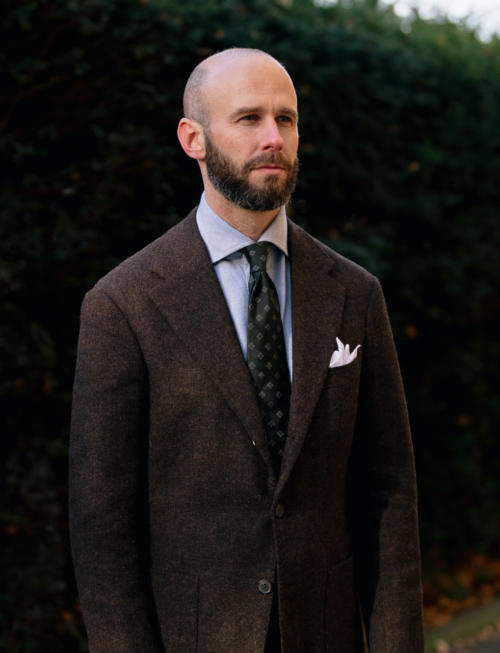
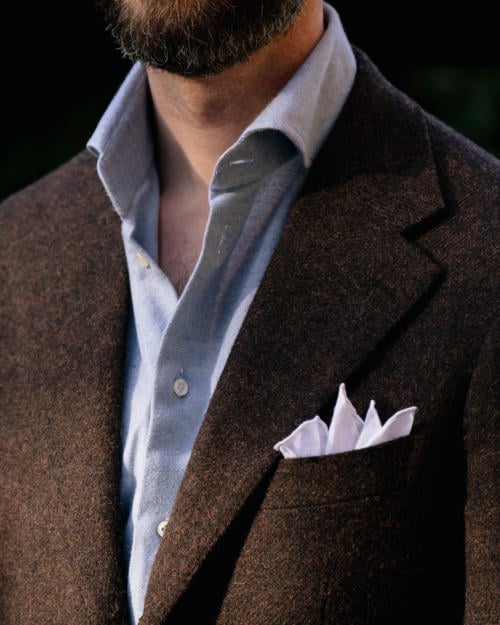
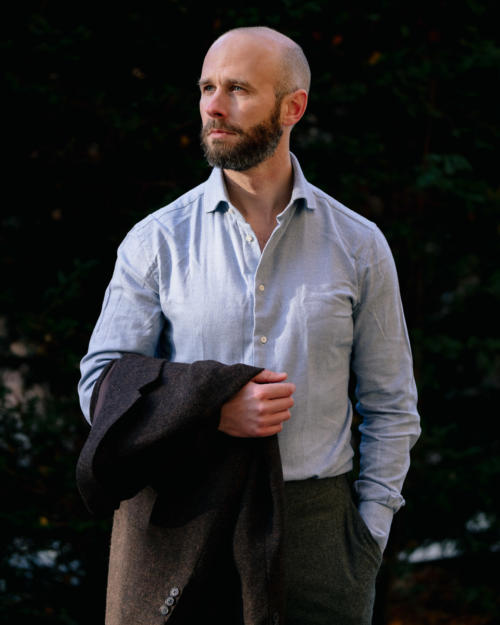

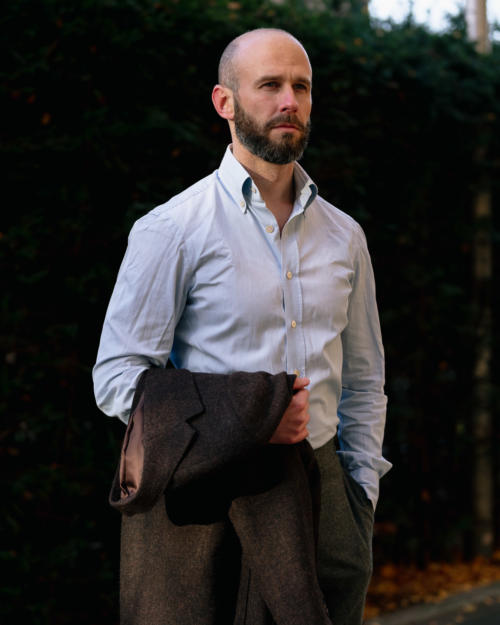
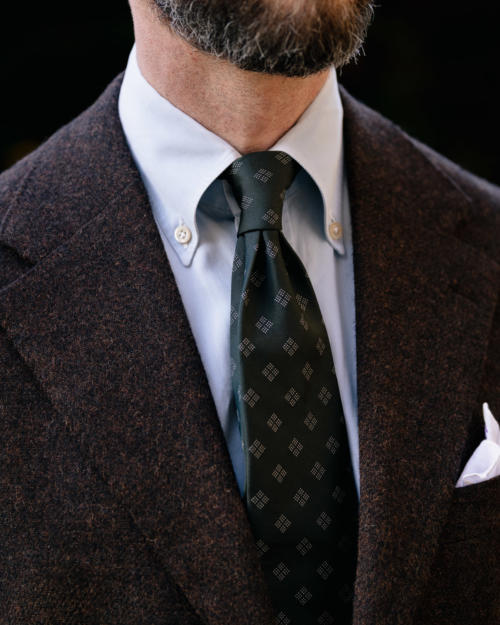
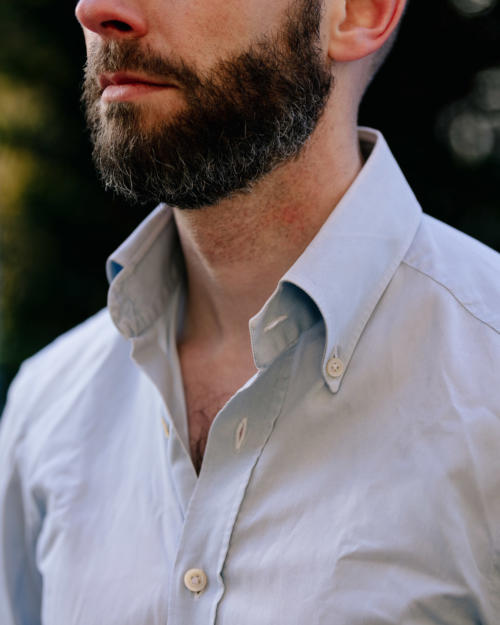



























While I’ve only tried Luca via the friday polos, that spread collar is already better than most, and that’s OTR. Given the opportunity, I’d love to have him make me some shirts with personalized collars too.
Thanks Simon. Definitely a bit surprised at how big your collars are, do you think this is noticeable vs what bespoke makers typically make?
How much of this collar size is what suits your face vs your personal preference (I know hard to split out)
Hey. I think it does look larger here compared to the collar on the WW Chan, as mentioned.
But no, it’s pretty typical for what a bespoke maker would cut for my neck length. Makers I’ve had haven’t varied that much in that regard.
It is hard to split out, yes. It’s a mix of flattering my face/neck, working with other clothing, and personal style. They’re all significant factors – doesn’t make much difference what exact proportion they’re in.
So collar back height at 4.4cm equals about 1 3/4 inch I think? In my book that is not particularly tall, mine are made to 2 inches, though I’ve had also 2 1/4 and my neck is quite short.
Wasn’t 1 3/4 the standard height for some Jermyn st makers before (T&A for example)?
That is pretty standard for most traditional English shirtmakers, yes, though you’ll find it looks pretty tall if you have a jacket that has a lower collar. And it tends to look taller without a tie as well
Thanks Simon. Do Italian bespoke jackets typically have a lower collar?
It seems that the collars of suit jackets should be subject for a separate post by you 🙂 How it has changed during the years (see classics like what Fred Astaire etc wore, not to mention DoW).
Sure, that would be nice, though I think it’s mostly a variation between tailors and regions rather than one over time. Yes, the Italians do tend to be lower
Beautiful pictures, I think you have nailed the collars in these shirts. I also love the jacket, I think one of the best ones you’ve reviewed recently.
Out of curiosity, do you know what cloth is the brushed cotton you mention?
I don’t I’m afraid. I know it was a Canclini herringbone, but also, it’s old and these collections change fairly often – outside of standard poplins and twills.
Hi Simon
Very useful article. It’s something I hadn’t really thought about in detail but makes perfect sense. Just one question. Do the straight collars have ‘bones’?
I find removing them helps with the S shape but they curl sometimes during wear. What I have definitely learnt here is to buy slightly bigger straight collars. That said long point button downs are my preferred unless for very formal wear.
Thanks.
No worries Stephen.
No, generally the collars don’t have bones/stiffeners. The spread ones come with them, but I take them out, because as you say the roll can’t be achieved without them
The only time I use them is with a tie, when the material is a little light and flimsy, and so could do with the support
Hi Simon – I’m not sure I understand the comment about floating construction.
You say
“… a result of the way they’re shaped and their lightweight floating construction.”
and go on to say
“A floating lining on a collar is harder to curve this way, and most significantly doesn’t retain that curve once it has been shaped.”
If the curve is a result of the floating construction, how is it good that the floating construction doesn’t retain the curve? I’m confused!
Sorry AVI, that’s a typo. The first one should say fused. Thanks for pointing it out
Thanks Simon, interesting article as always.
I look at the photo with a tie and I realize that the space between the neck and the shirt is not big. What distance do you think is comfortable for long time wearing?
I find a good guide is that you should be able to fit two fingers between shirt and neck – it should be a squeeze to do so, but you can.
But it is personal too – and as long as you can’t visibly see the collar hanging off the neck, that’s fine.
Hi Simon, the point length is a topic I find interesting as it can have a quite an effect. In your article “how wide should my jacket lapels be?” you mention that the jackets are fairly consistent in lapel width. Are there similar ranges for collar point lengths?
Hi Charles,
Do you mean do shirt collars in general vary that much, or mine in particular?
If mine, then no I keep pretty much all mine in the proportions of these two shown.
If in general, then yes these vary a lot. A lot of modern shirts have very small collars, which don’t look great with jackets.
Hi Simon, I was referring to collars in general. Spearpoint vs a tiny point collar. At 3 inches mine now seem to be on the small side so having your sizes is useful as a reference.
I see. Ok, thanks Charles
Hi Simon, is there still a place for double cuffs in the current sartorial environment ? I have some bespoke shirts from Luca that I haven’t even worn yet – is it possible to have the double cuffs turned into single ?
If exactly the same cloth is available, then yes the cuffs should be able to be changed.
I’d say double cuffs will still have a place, but only with suits and the smartest jackets really, so it’s a question of how often you see yourself wearing those.
Do you have any thoughts on keeping unbuttoned collars upright when worn without a jacket? In my observation, this primarily occurs as the fabric of the body of the shirt under the collar band loses integrity with wear and relates to the collar itself only insofar as a higher, more heavily lined collar is heavier and more disposed to collapse. The lighter the body fabric, then, the lighter must the collar be (i.e. less lining, smaller) to retain stature. Counterintuitively, collar stays actually makes the collar more prone to collapse.
Also, typo: “I’ve zeroed in on these two collar styles because do that”
Interesting point. Yes I can certainly see why heavier fabrics and linings would do that, and indeed why collar stays have that effect too. They’re really only designed to keep collars straight, when a tie is worn, rather than anything else.
I do find that my points above about a collar with some soft roll does make a difference here. And you can shape the collar a little into that shape if you need to, even when not wearing a jacket.
But fit will also make a big difference. A collar that sits well on the neck and collar bones is much more likely to stay upright – something that largely only comes from bespoke.
I use aluminum collar stays sometimes. I’ve bent them to a curve, which helps the collar stay up with a jacket.
Fantastic article as always, Simon. On the subject of collars, and collar stays in particular, are there any advantages to having removable vs permanent ones? I’ve seen some RTW shirts have permanent ones but can’t see why one way would be any better than the other.
Well, collar stays are really only designed for keeping the collars straight and sharp when worn with a tie, so if you ever don’t wear a tie, you might want to remove them. And you can’t do that if they’re permanent.
Permanent ones also have a habit of getting bent and distorted in the wash. It’s usually a good idea to remove them before washing.
Hello Simon, perhaps the only thing missing from this article is the weight (or thickness) of the fusing you have the tailor use, spread collar versus button down – and for spread collars, whether you use a lighter weight for shirts intended to be worn more casually, usually sans tie?
Cheers,
N.
Good point Nick. I’ll ask what the weight of fusing is. I don’t tend to vary it with either the collar style or the formality though – the only time I vary it slightly is if the material is particularly thick.
At the extremes, I might have something different for a very casual shirt – eg a very light fusing or very light floating for something like a beach linen shirt.
Very useful article, thank you.
Have you any more thoughts on one piece collars for spring/summer shirts to be worn without a tie? I’m sure I’ve seen pictures of you wearing them, but not enough to think it’s something you particularly favour?
No, true. I do have one from Marol that I like, but I find the style a little showy to be something other than a nice variation from the norm. I also prefer the style with a jacket usually – it can look a little wide or large without one.
You can see that shirt here.
Any chance of offering your spread collars shirts on PS Simon?
No, sorry. It would mean doubling everything – either that or cutting in half the styles on offer
For work I usually wear straight collar dress shirts with an odd jacket. To prevent the collar from collapsing, I use metal collar stays which are held in place with a small, very strong rare earth magnet on the inside of the collar. They work great and keep my collars standing up all day. Highly recommended.
This happens to be the two styles of collar that Anglo-Italian offer, and which I am hoping to commission via their M2M service later in the year. I appreciate that much of the refinement discussed here would only be possible via bespoke, but do you think there is scope for any kind of adjustments to the collar dimensions via M2M? Or is it more important that, like for RTW, the general construction follows these principles and the fit works for the individual? One more question if I may: I remember you tried AI’s RTW shirts briefly along with a jacket commission; do you have any thoughts to share on their shirt construction and style with respect to the points discussed here? Cheers!
Hey Josh,
The AI shirts do come in both a button-down and a spread, yes. The shape of them is different to mine though. Not huge differences, but then all of this is only small differences. I wouldn’t say they were the same.
The collars won’t be able to be adapted with MTM, no. At the most, with MTM you can sometimes pick between different collar shapes on offer (eg someone like Simone Abbarchi would offer this). But you’re not going to be able to start re-cutting or re-designing it.
The AI shirts are nice. Not made to the same level as higher end ones, like my bespoke or the PS ones, but still good and similar value. On the style, I can’t remember what the spread is like, but the button-down is a bit more similar to the Drake’s ones – lower collar, slightly shorter.
Super, thanks for the thoughtful response, Simon. I also have a long neck and would definitely benefit from the higher collar and other proportions that you have refined for your shirts with your makers. But a key problem I have with RTW shirts is sleeve length! The high street collar-sleeve measurement system is sorely lacking among the craft makers we revere. I previously extolled the virtues of the Berg &Berg collars – they are great, high, and well structured but the dreaded oxford shrinkage got me in the sleeves. Beyond those, I have some old Brooks Brothers OCBDS which are actually long enough but suffer from the short unlined Ivy collar issues when it comes to tailoring, and their UK pricing now is higher even than Drakes RTW. All of which is to say, I’m looking for a collar approaching those of yours, at a length to accommodate my uncompromisingly long limbs, at a price that ensures the minimum level of quality that we would expect here at PS but also allows me to wear the shirts without the acute anxiety of spoiling them ?
Quite a conundrum.
The issue with sleeve lengths I think is just that most companies we cover are smaller, and they can’t afford to offer multiple lengths. Unlike big high-street names.
My RTW everyday denim shirt measures 4,1cm at the band and 4,6 total. Which makes it taller than your bespoke ones.
I have considered your collars very high some while ago. But the other well known neapolitan RTW shirts that I own are also made with a collar band at 4cm. So it has become rather standard.
I would argue that a high collar does not have to look bad on average or a bit shorter necks, as long as it is open necked. Because at least from the front it is open enough. Maybe that is why Mr. Migliarotti looks good with his high collars. Still trying to figure it out.
Good point Alexander – it’s much less noticeable, more of a style point, when worn open. As with everything, height in relation to neck length is also only one factor. Something you should keep in mind, but not that should ever make the decision entirely.
Style is always a big one, and as Gianluca shows, he prefers that higher collar for the style. Equally, there will be guys with longer necks that prefer the unlined Ivy style, which often had a smaller collar. It will look a little slouchy with jackets, but that’s the look they like.
I read your articles with great interest and they are most informative. So…I’m 95 % a fan. I would like to make a comment if I may. You’ve mentioned a few times about neckties being “phased out.” I disagree strenuously. A TRUE gentleman does not leave the house without a necktie. In fact, in my firm,,,no one would dare appear without a tie. I wanted simple to offer a different perspective. So…please…stop promoting the sloppiness of no necktie. Instead , you could emphasize its importance.
Thank you Dave. I appreciate the comment, but I’d make two quick things in reply. One, whether you wear a tie has got nothing to do with being a gentleman. Or with cigars, cars or women. Being a gentleman is about kindness, propriety and courtesy. And point two, it’s not my opinion whether ties are being phased out. It is the trend in society. And much as we dislike it, the majority of what is appropriate, as well as what looks good to us, is dependent on society around us.
Nonetheless, I will always express the virtues of wearing a tie. I just won’t do so for your reasons.
To add to Simon’s comments, being a gentleman would probably not include wearing a costume, and in most firms (irrespective of industry – I work for a law firm) wearing a suit and tie when you haven’t got a client meeting now looks like at best an affectation and at worst like office cosplay. I’d say subtlety is important, as well as not standing out for the wrong reasons. I save the ties for the occasions that they are appropriate and attempt to dress well, but appropriately the rest of the time.
Fully agree, you can be a gentleman in jeans. Times changes and many non-traditional companies don’t have any dress codes, but of course a sense of style is still important.
Simon,
Being a gentleman is indeed about propriety and courtesy, and both are more clearly demonstrated by wearing a tie, or at least buttoning all the buttons but the collar button if one goes tie-less.
The element you’re missing is that propriety is not about what you think looks right – it’s about what others think. And that’s not the society the vast majority of people are living in today.
So women go after cigars and cars… it is good not many of them visit here… otherwise even a perfect tie wouldn’t help)
I enjoyed the post, thank you.
It always used to bug me that Charles Thrywhitt shirts said their buttons were sown on so securely they would never fall off. So why did they include spares?
Emmett shirts work well for me esp. their button down collars but they aren’t always available so I’ll look up at PS button down as they sound perfect and a similar price to Emmett.
Good to know Rich. They are rather better made than the Emmett ones, at least in terms of the functional handwork – hand sewn collars, armholes, then buttonholes and buttons too.
I think the spare buttons are provided in case buttons break or get chipped.
Good point.
Very nice article. Btw. do you prefer pocket shirt or non-pockets? I feel kind of naked without pockets/details . Guess it depend on the use/formality. Any articles on the theme?
Not on that specific aspect of shirt style, no, though we are assembling a guide slowly (here) and I’m sure that will appear in it at some point.
Pockets on shirts made them more casual, and I tend to prefer the shirts without as a result. It means I’m more likely to be able to wear them with fairly smart tailoring, and yet they still look good with jeans. Shirts with pockets don’t work as well the other way around.
I think there may be a cultural divide here. As an American, I find OCBDs on their own (ie with jeans and a belt) tend to more often have a pocket; and that same shirt can often slide under a jacket (not a suit) with a tie without any real fuss. But for smoother cotton shirts with spread collars, I like an uninterrupted chest. Maybe this is a sliding scale of formality: shirts edition
Yes, perhaps, and it is cultural too.
Hi, may I please ask what’s your average collar height at the back for a jacket?
Hi Henry,
Well, as mentioned on this post, it does vary quite – from around 3.75 to 4.5cm. However, bear in mind that just as important is how high the collar is placed on the body, as well as the height of the collar itself.
Mr. Crompton,
The first button below the collar button is meant to be buttoned.
It would show far more self-respect and respect for others if you remembered this.
Marshall, it really isn’t. There may be the odd occasion – if I were working in a particularly formal office for example – where I would reconsider whether that number of buttons being open is too casual. But for the vast majority of people, the vast majority of the time, it’s fine and certainly no one is shown any less respect.
And referring to ‘meant’ or ‘should’ without any knowledge of the wearer’s circumstances manages to both be unhelpful and silly.
Simon,
As a loyal follower of Permanent Style, I thought I owed it to you to alert you about this matter.
Unhelpful? Silly?
Quite the contrary!
Why not ask your readers what message is being sent by leaving that button unbuttoned?
Thank you for bringing it up Marshall, and it is an interesting point. It’s just one we disagree on.
I personally think it’s unhelpful to be that didactic about a style point which is clearly there for a specific reason – to be smarter, to be more flattering or not – and considering those reasons is why someone should or shouldn’t wear something, not just because someone pretends there is a ‘rule’.
And it’s silly, because no one outside a formal meeting in a formal office will possibly feel disrespected by the choice of undoing that button. It’s unfortunately probably more about how you feel about it, than what anyone else does.
Thank you for your detailed reply.
One wonders what Bruce Boyer would say about the matter.
Bruce and I speak about the topic often Marshall. I know what he would say.
Still to your guns here Simon. I’ve worked in the most formal of offices and environments (in diplomatic, banking and corporate circles; home and abroad) and have no doubt that buttons and collars have little to do with respect or self respect. It tends to be the anxious guys, eager to conform (or exclude) who associate rules of dress with respect or courtesy. Dress with modesty is my only real rule.
Nicely put Matthew
This post about collars is very apropos for me. I recently had some bespoke shirts made, all in PS cloths. This was my first experience with bespoke shirts, and I was very struck by the heights of the collars compared to those on the MTM shirts I’ve been wearing for years. Of course, I now understand that the collars on the bespoke shirts are as high as they are to accommodate the jacket worn over them, as you discuss, but the height takes a little getting used to for the uninitiated. Nonetheless, I’m compelled to ask why most RTW and even MTM shirts have collars that are so low, in comparison to those a tailor would typically make for a bespoke shirt?
I think it’s a combination of a lot of RTW shirts not being designed for tailoring, but for wearing without, and a fashion thing of collars being smaller – lower and shorter
I see the point for a limited variation in collar styles, but don’ t you think there are shirt styles that call for a specific collar? E.g., a denim shirt with all the western details, yoke, snap buttons, maybe sawtooth and the like, require in my opinion long points irrespective of face shape. Or playful tropical with camp…
Yes, good point Nico. We’re talking here really about smarter shirts than either of those – pieces from a robust oxford like this up to a sharp white poplin.
More casual ones, or perhaps just stronger styles, need their own shapes.
Thank you! This was very appreciated because I’ve been trying to achieve precisely this concept, and the measurements provide a great guideline.
Out of curiosity, did you have the problem of realizing you had too many shirts? I mean I still have many great rtw shirts when cotton was still really good at a mid-market price – one of your earliest blogger posts described how you tapered your shirts, and I tried it myself. Great tip btw! Just can’t get myself to part with them because they’re still in great condition, and I went crazy with the sewing machine.
I’ve been hand washing and ironing my shirts during this lockdown and I can’t believe I have so many.
I have done at times, yes, though that’s largely been when I find I get too many variations or colours, which don’t end up being worn
Great article, as always! I was wondering if you have ever heard of Crichton Bespoke. They are a shirt maker and tailor based in Chester, but they have an office based in London. I am looking at commissioning some bespoke shirts and suits and I would ideally like to support a local tailor as long as I do not sacrifice too much in quality.
I’m afraid I don’t know them Liam. It does look like they are doing real bespoke, even if the style seems a little flash. Beyond that I can’t really comment I’m afraid
Why not mix in a band collar?
I used to wear them, but they feel a little gimmicky now. Mostly a fashion thing probably
Hi Simon,
Since you’re British, I thought you might know the reason. Why we never saw male members of the Royal Family (Prince Charles, William, Harry, etc) wear button-down shirts? Is it not popular in the UK, or is it too informal for them, or something else? Thanks
I don’t know, but I’d think it was a mixture of both. Button downs have never been as popular here as in the US, and they are less smart, so not usually worn with smart shirts or with business clothing. Or something as smart as most royal occasions.
Hi Simon.
Great article please as always.
I wonder do you have a view on the best shirt collar style to be worn under knitwear?
Specifically, with a v neck pullover, as I am forever finding the collar escapes the pullover, leaving the overall look untidy?
Many thanks,
John
Hi John,
If the issue is that the collar escapes outside of the V-neck, then chances are it is a bit too small – longer points would probably help.
Also, if you don’t mind the style, a button-down collar is the safest of all, as the points then aren’t going anywhere.
What is your opinion on band collar shirts? I was thinking of buying one for casual wear.
They can be a nice alternative style, but personally I don’t like them or wear them. The band is often a bit low for me and doesn’t suit by neck or head. And in every situation I’d rather have a more standard shirt collar, just in a different material rather than design
For casual shirts can I go with stiff collars rather button down. Which of the two would look better on casual shirts?
A soft collar, definitely. Doesn’t have to be button down, it can be a point or even a spread. But avoid the stiffness
Would a stiff collar look good with polo t shirt? A soft collar does not feel very attractive to me
Not a stiff one probably, but a higher and better made one can. Have a look at our Friday Polos – that’s what they were designed for
Hi Simon,
I was wondering how do you know when you’ve found a collar that suits you really well? This is irrelevant to this particular article but how do you know when a jacket and pair of pants fits you well. Thank you in advance.
They’re all big questions Kyle. I think you need to read the articles I have written about having shirts made over the years, and similarly on jackets and trousers, and pick up the details. For example this on jackets, and also this
Are you doing those kinds of searches and reading around before asking more questions?
Hi Mr. Crompton, I’m meeting with Luca Avitabile next week for my first ever bespoke shirt. Do you have any recommendations on button spacing for the front of shirt, especially the second down from collar, or are they normally all spaced equally apart? Also, a recommendation for cloth/color and collar style that would be most versatile as casual/more formal wear as well? Or any other details you would recommend I discuss? Thank you, if I missed a related article, please direct.
Hi Dave,
Buttons will normally be equally spaced, just have a think about where you normally have your shirt open to, when it’s worn without a tie, and consider where you like that button to be.
There are lots of good articles on this. Have a look at the guide to shirt fabric, and the guide to shirt style
Hi Simon,
I guess that you with Luca Avitabile made the BD collar and collar stand with a light fused lining, am I right? I also believe that original BDs used a light floating lining both in the collar and stand and the later unlined version was not supposed to be worn with jacket and tie. Wouldn’t then a light floating lining in collar stand and no lining in collar itself be the perfect solution for “soft” look that also could be worn with jacket and ties?
And do I understand correctly that by your own design of the BD collar you were aiming to bring back the original (Brook Brothers etc.) look, i. e. always with the roll? I’ve read somewhere that through time the roll was lost even with those original manufacturers. Or do you see your version different from the original (Ivy) look? I think the “originals” looked great with jackets as does yours.
Thank you very much in advance!
John
On the lining, yes you’re right it would be smarter if the collar stand were lined but not the collar itself. However the collar would still be pretty floppy (I’ve sampled it before with Luca) and not the look I’d want with a tie. There is an aesthetic there, but it’s not mine.
I love the roll of a BD, but I wasn’t specifically trying to bring back that Brooks look, no. It was more what I personally liked about the idea, my interpretation. Hence the roll is actually a little more than old examples I’ve seen, and the collar a touch higher
Thanks for tips, Simon. I’m going to try to model with my shirtmaker a BD perfect for me and I’d also like to understand one more technical thing. I’ve always thought that for the roll the positioning of buttons is crucial (or maybe only) point, but I also read that the roll is the result of intentional difference of shapes of collar and collar stand. I’m not sure if I can imagine what that means. Is there really any special approach as to how its cut?
And by the way, the tie gap on your BDs is also 2 to 3 mm? That seems pretty close for BD, anyway.
Thanks again!
John
Hi John,
That shape in collar and collar stand can make a difference, but it’s a very small one in my experience (eg D’Avino shapes this more, and Luca Avitabile less, but to little noticeable effect). It’s 80% button position, 20% collar shape
Hi Simon, I was wondering if you have tried the button-down collar from Simone?
Is it usually possible to request shirt makers to have the height and length of the collar cut to my preference?
Many thanks,
Jack
I haven’t, no.
That is usually possible with bespoke, yes, though not usually with MTM. Simone offers both
I see. Thanks, Simon.
I always mostly only unbutton the top button even when I am dressing casually but with a lot of gentlemen and also with regards to your photos i have seen two buttons undone most of the time.
Does unbuttoning only the top button while wearing a shirt alone looks uptight?
Your suggestion would be appreciated.
It can do I think, yes. I also think it’s more flattering on most men to undo two buttons
Hi Simon, I know it’s not your specialty, but can you say something about the shirts from Proper Cloth? I was looking for Made to order (long narrow neck but broad shoulders) with the possibility of ordering higher collars. Their Roma collars look promising. I have never heard anything about them, so I am grateful for any comments from you or other readers.
Thanks!
I can’t really, sorry, as I haven’t tried them
Hi J-K-F – I am a big fan of Proper Cloth and have over time moved my entire shirt collection over to it. I originally tried them out for the same reason, collar style selection, influenced by Simeon’s articles on the virtues of high collars 🙂 and have found them to be the most configurable (love, and need, their sloping shoulder and neck forward settings!) MTM option around. Great fabric selection and customer service/responsiveness as well. I experimented with both soft and fuses/regular Milano and Roma cutaway as they were closest to the measurements Simon had in his article on collars. Milano is just a hair larger and Roma a hair smaller. In the end I have settled on Roma cutaway as the best option for me, with the soft version for linen and fused for everything else. Hope that helps.
Happy New Year Simon!
I have my first question of the year for you…
I think I have a pretty long neck, although this way of comparing would certainly not be accurate enough. Still, the collar of my bespoke Luca shirt, which has precisely the same back height as yours, sits lower on my neck than yours. So, I then had several button-down shirts made with the stand-back height of the collars as 4.5cm, which I think looks a bit more flattering than my other shirts with 4cm back height collars. The only downside would be that they are less comfortable around my neck and look slightly dressier when I also expect some comfort from wearing button-down oxford shirts. As you mentioned in your article, since you prefer shorter collars for casual shirts, I was wondering if you think I should make the back height of the collar shorter for the shirt to overall look more casual.
Many thanks,
Jack
Yes, I think that’s worth trying Jack, you may well prefer it
The PS ready to wear LA shirts have a collar band of clearly under 4 cm (in size medium). That is probably why their collar doesn’t stand up as high as the ones from Simon. So readers that are ordering the RTW option should be aware of this. My OCBD from Anglo Italian for example are clearly higher than 4 cm. I am just in the process of adapting the collar height with my latest MTM from Luca. Really looking forward to my PS pink oxford cloth.
Nice to hear Alexander
Simon, you favour a fused lined collar for dress shirts, that do have some obvious advantages. But what to do when the fusing starts to bubble/weaken? Is there remedy? Has happened on some sadly expensive shirts (Shibumi). Thanks.
To be honest I haven’t had that happen Stephan. Could you send me a picture perhaps?
Thanks, Simon. Had just put it in the washing, will take a photo once washed and tried. It’s really a bit like a puckering of a fused suit, a bit of a bubble here and there and an indent or two. Will send a pic, might not be explaining well.
Hmm, OK thanks
Hello, Simon! Here three photos where I tried to catch the issue in different places on the collar.
Hey Stephan,
They’re a bit blurry, sorry it’s hard to tell! The only thing I would say is that it seems very small, and if the fusing were coming apart, you’d expect more bubbles across an area.
Thanks, Simon. Only one photo was possible to upload so I combined three. It is difficult to photograph on white too. In case it were the fusing coming apart, would there be a way of fixing it? It is more visible in person than in these pics. Thanks.
If that were the issue, you’d probably have to replace the collar Stephan, I don’t think you could just take the fusing out
very stylish collars
Hi Simon, I was wondering if you ask the shirt makers to lower the second button from the collar so it could open like yours in the photos? I have been commissioning my shirts from Luca and Simone, but the shirts never open like yours when I unbutton the second button they just stay closed almost as if the buttons are done up.
Many thanks,
Jack
I do specify the position of that button, yes
I see, do you have any suggestions on what I could do for the shirts to open more if they have already been made and if the buttons are not low as yours?
Press them open perhaps, roll them around the lapels, or store them folded with the top button undone, with other things on top
I will try, thanks for the suggestions.
Hi Simon,
May I ask what is the distance between the pointed tip of the collar to the folded creased part of the collar? Is it 3.5 or 4 inches?
Hi Jeriel,
I’m not entirely sure what you mean – I assume you mean the length of the collar on the front edge, which I’ve listed as 9cm
Hi Simon,
Apologies on the 2nd message, may I ask what you mean by distance between points?
No worries. When the collar is fastened, the distance between the points of the collar, where they sit on the body
Thank you for posting this information.
I have noticed that the point length (width) of shirt collars in the UK is too big for me; it was when I was in the far east on holiday and decided to buy some shirts over there that I noticed their collars were generally smaller in point length (4.5cm) and they looked much better on me as a result – proportionally.
Are you able to recommend any RTW manufacturers in the UK that produce shirts with smaller point lengths on collars? Or a reasonably priced (just recently graduated so I don’t want to be too extravagant) bespoke shirtmaker who can make the point length of my choice?
Thank you.
A bespoke shirtmaker can certainly make that length. Simone Abbarchi is the best for the lower budget. However, to be honest I find most mid-market shirts are more that smaller size, and I prefer them longer!
Ok, I’ll take a look at some of those mid-market options as well and see what sizes they have.
Thanks for your reply, much appreciated.
Have a look at Finamore, I find decent range of options and good price to quality.
Hi Simon,
For your spread collar shirts, do you use a fused or soft placket? For example, in this article, your spread collar shirt has a French placket; is it fused/lined/soft?
And in your experience does placket fusing/lining factor into how well the collar stands with or without a jacket?
What are your preferences?
Thanks!
I generally have and prefer a light fusing, I think it goes well with the collar and cuffs being the same.
But no, I don’t think it makes much difference to how the collar stands. A bit, but the cut and front height of the collar makes a much bigger one
Hi Simon, Have just recieved my first shipment from Luca and they are fantastic. Don’t know why it took me so long to get into the value of bespoke shirts but they’re fantastic- I am a firm convert.
I wondered in which scenarios you’d wear a BD vs open collar spread? I am trying to evaluate as my build my wardrobe which would be most appropriate.
Thanks for the steer!
Nice to hear PM. Have you seen the Shirt Style guide in the contents? That answers a lot of these things. You might also find the Shirt Fabric guide useful too
I have a shirt which has soft big collars which tend to be a bit floppy. Would adding it a button down collar to it through a tailor be a good idea?
It depends on the shirt – whether it suits the style (eg good on an oxford, not on a western shirt), and whether it suits the collar style (point collar yes, cutaway collar no)